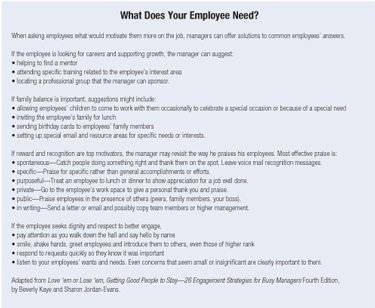The Public Manager Magazine Article
Why Employee Morale Matters—Especially Now
The solution to engagement and retention issues is the ability of the manager to truly understand what is in the hearts and minds of their employees. The right dialogue can motivate employees to stick around and not just be part of the change, but help drive it.
Fri Mar 14 2014

It's been a busy time in our nation's capital. One of the biggest political contests in recent history is well behind us, government closure is held at bay, and affordable healthcare is raising more questions than it has answers. We now await another "perfect storm"—the threat that employee disengagement poses to government agency stability as transformational change seems to be more the norm than the exception.
With much talk about change, leaders with an engagement and retention mindset are concerned about another potential cut: the reduction of engagement in the government worker. Surveys measuring overall employee satisfaction attest to the fact that government workers are more disengaged on the job than their private sector peers.
And with the possibility of a more economically optimistic four years on the horizon (barring significant cuts to government programs), this disengagement can spell trouble for agency stability as it relates to employee retention. As the dust settles after recent office closures and sequestration, turnover can be directed to either the more positively perceived private sector, or more forward-thinking government agencies. Leaders and managers are the driving forces that can determine the outcome.
Employee disengagement is the single most important factor in declining productivity, which leads to higher absenteeism, higher costs of doing business, and all around poor performance. While these elements are rather broad in their sources, the causes of employee disengagement can be even more evasive. Recent research from the Saratoga Institute, Gallup, and Career Systems International (CSi) shows that managers and supervisors play a significant role in the level of disengagement that an employee experiences in both the private and public sectors.
Studies suggest that the number one reason why people leave their jobs is their boss. Women cite management style and great bosses as a "stay factor" more frequently than do their male counterparts. As the female vote proved critical in the last election, the retention question of "how do we engage the genders?" becomes more critical. The good news is that much of that question can be answered fairly easily (and cost effectively).
Factors that Contribute to Disengagement and Turnover
Many factors weigh into the manager or supervisor engagement formula. CSi, a global company that helps organizations maximize strategic engagement, development, and retention, cites certain high-risk behaviors (also known as "jerk" behaviors) that most often contribute to employee disengagement and subsequent turnover, such as favoritism, micromanaging, and not caring.
The opposite of employee disengagement is obviously employee engagement—the level of loyalty and productivity that one brings to the workplace. Leaders who want to increase their operational effectiveness on any level will focus on things that bring a workforce that is engaged and productive. The question is, how?
Let's look to some potential areas of improvement. The Federal Employee Viewpoint Survey (FEVS), an assessment tool "that focuses on employee perceptions that drive employee satisfaction, commitment, and engagement, which ultimately contribute to the mission of agencies," provides information that can help drive change across key areas within and throughout federal agencies. Although the survey does not represent 100 percent of the federal population, the 2013 FEVS, with a response rate of 48.2 percent, has some pretty well-represented data. The survey can provide a roadmap, of sorts, to assist interested managers and supervisors on how to develop an environment that people want to work in and where they can be most effective and productive.
Here is the good news. The 2013 FEVS highlights that government employees are willing to put in extra effort to get their jobs completed, and are finding ways to do their jobs more efficiently, with a special emphasis on quality. That said, marked decreases from the 2012 survey surfaced: workers face challenges such as insufficient resources, lack of recognition of performance variances, inability to deal with poor performers, and overall satisfaction with pay.
This decrease was directly responsible for fewer employees recommending their organizations as ideal places to work. The data are particularly noteworthy because they relate to overall satisfaction with government work, suggesting that while retention within the government sector is good, opportunities for employees to cross agencies, or leave to secure work in the private sector, could be particularly high.
Beware the Engagement Cliff
While the news is good for now, employee engagement often falls prey to major changes and challenges in any organization. Beware of the potential "engagement cliff." If managers and supervisors get complacent or let old operational behaviors continue without change, government agencies may see a large number of talented employees jumping ship to other entities. Both the public and private sectors offer exciting work and challenge, development, and great people to work with—the historical top three reasons people tell CSi why they stay.
In a breakdown of stay factors by industry, recent data suggests exciting, challenging, and meaningful work still outranks all other stay factors for government workers, while supportive managers and a good boss come in second with this specialized class of worker. What is interesting about this finding is that in earlier studies, working with great people and career growth outranked supportive managers and bosses as top reasons why people stay. Now, managers are the top driver in how engaged their workforce is and subsequently how it performs, but are also the single greatest risk of turnover (no pressure here!).
How can a forward-thinking agency manage this potential engagement cliff? Assessments on agency climate—meaning the prevailing conditions of a governmental area—suggest there are three force fields that agencies are dealing with: external forces, internal forces, and cultural forces.
Obvious external forces or challenges are the budgets, IT or technology, social media, and agency consolidation. Internal challenges include retirements (and loss of intellectual capital and legacy), downsizings to cut costs, program consolidations, and appointee changes and shifts.
The cultural challenges are the ones that hit most close to home and are the ones that can be directly impacted through the manager-supervisor-employee relationships, and they are factors such as generational differences, program or agency collaboration, increased emphasis on social media as a communication tool, and the need to be flexible to teleworking.
The solution to the engagement and retention issue is the ability of the manager or supervisor to truly understand what is in the hearts and minds of their employees as it relates to the aforementioned forces. A dialogue between the manager and the employee, often known as a "stay conversation," raises these key issues. The conversation allows the manager to let the employee know why he is valued within his organization, followed up by how the manager might be able to give the employee more of those "value" opportunities. The conversation may be as simple as:
Setting the stage as to why the employee is a valued member of the team. Cite specific examples of behaviors he has exhibited that contributed to the overall operation's success.
Asking a couple of key questions that allow the manager to dive deeper into knowing more about what motivates the individual. Asking the question "Why do you stay?", or "What is most important to you at work?" often uncovers a wealth of possibilities for engagement understanding and may provide solutions to overall engagement challenges.
Ideas for action is a collaborative opportunity to come up with thoughts on how to achieve better satisfaction for both the employee and the department in general. These ideas can help the manager build an infrastructure that supports overall agency initiatives while providing employees ownership for their ideas.
Solutions such as more collaboration with governmental agencies to share best practices, sponsorship to professional organizations, opportunity to network with others through cross-functional training, and training and development funded through tuition refunds, are solutions that can net high yields on the next Federal Employee Viewpoint Survey.
Local networking events, communication about agency-sponsored lunch and learns, and speakers and workshops are very effective ways to provide cross-functional understanding. They also provide opportunities to develop ideas to increase engagement and subsequent retention.
In the 2013 Federal Employee Viewpoint Survey, Office of Personnel Management Director Katherine Archuleta said, "Together, federal employees at all levels face challenges, uncertainties, and changes. Nonetheless, we strongly believe that our agencies are good places to work and that our employees will continue to be dedicated to doing their work, \[and\] serving the public in the best and most effective way."
Recognizing that some of this survey information could be "less than comfortable" in nature, the good news is that there are easy-to-implement, low-cost solutions in a leader's effort to develop a climate that results in higher retention, higher engagement, and proven higher levels of productivity.
If agencies are seeking an environment of change, what better place to start than a dialogue with those who know how to do it best, the frontline managers and supervisors? Who knows, managers may even provide a foundation that inclines its top-notch employees to stick around and not just be part of the change, but to help drive it.
[

The solution to engagement and retention issues is the ability of the manager to truly understand what is in the hearts and minds of their employees. The right dialogue can motivate employees to stick around and not just be part of the change, but help drive it.
](http://files.astd.org/TPM-Article-Images/2014/spring/CowartSB1-L.png)
